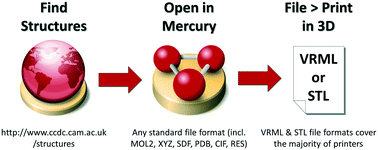The next dimension of structural science communication: simple 3D printing directly from a crystal structure†
Abstract
Communicating science is hard. This is particularly true for a lot of structural science concepts which are inherently three dimensional in nature such as molecular geometry, symmetry, intermolecular interactions and the packing of crystal structures. One of the most effective ways to get around this difficulty is to use physical 3D models for communication, whether it is in an outreach setting, through classroom education or even presenting research results at a conference. Recent studies have shown how to generate instruction files to 3D print experimentally accurate models. Here we present for the first time how scientists can do this from any standard structural model file (incl. MOL2, XYZ, SDF, PDB, CIF, RES) easily using the well-known, freely available structure visualisation program, Mercury.



 Please wait while we load your content...
Please wait while we load your content...